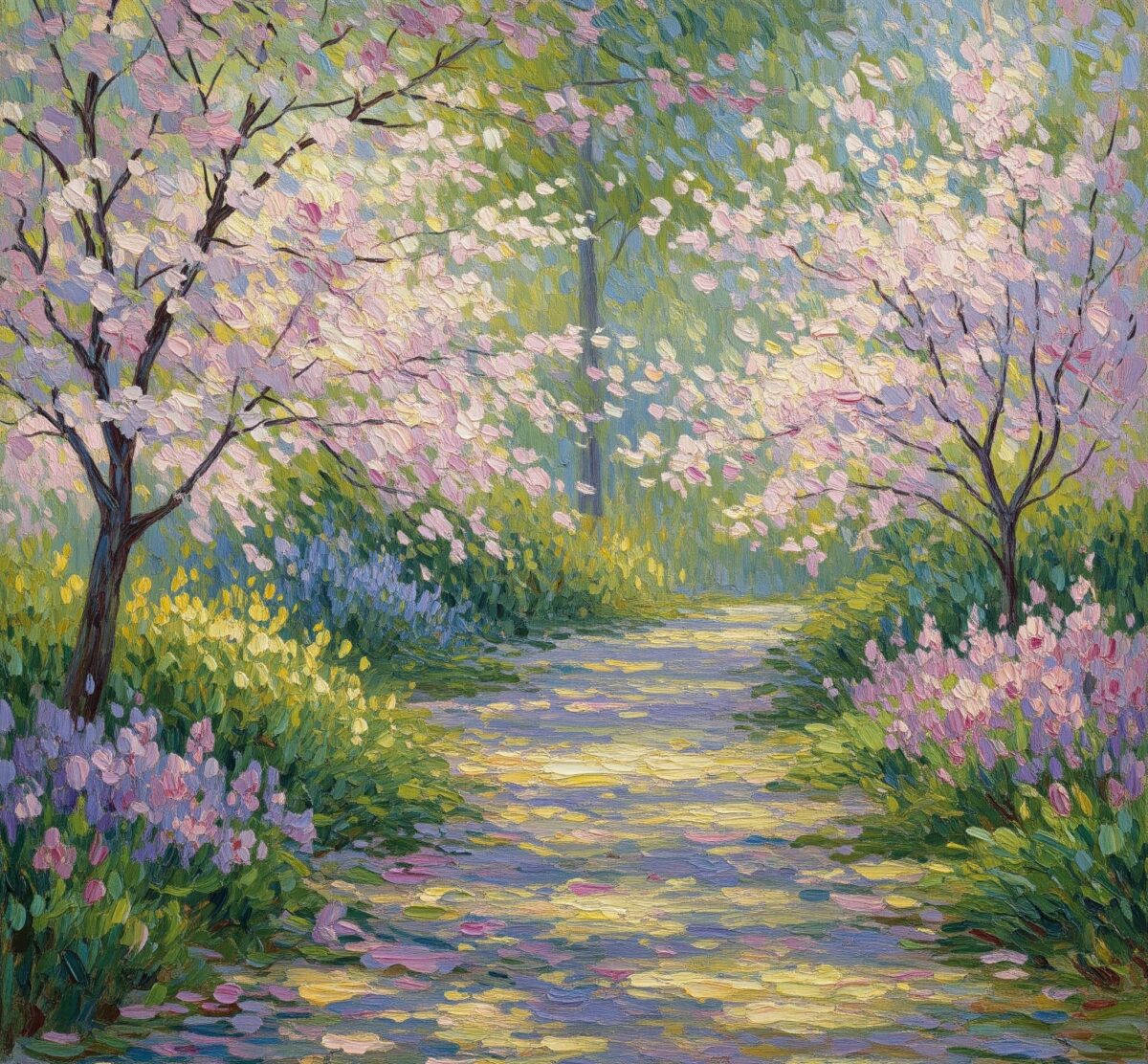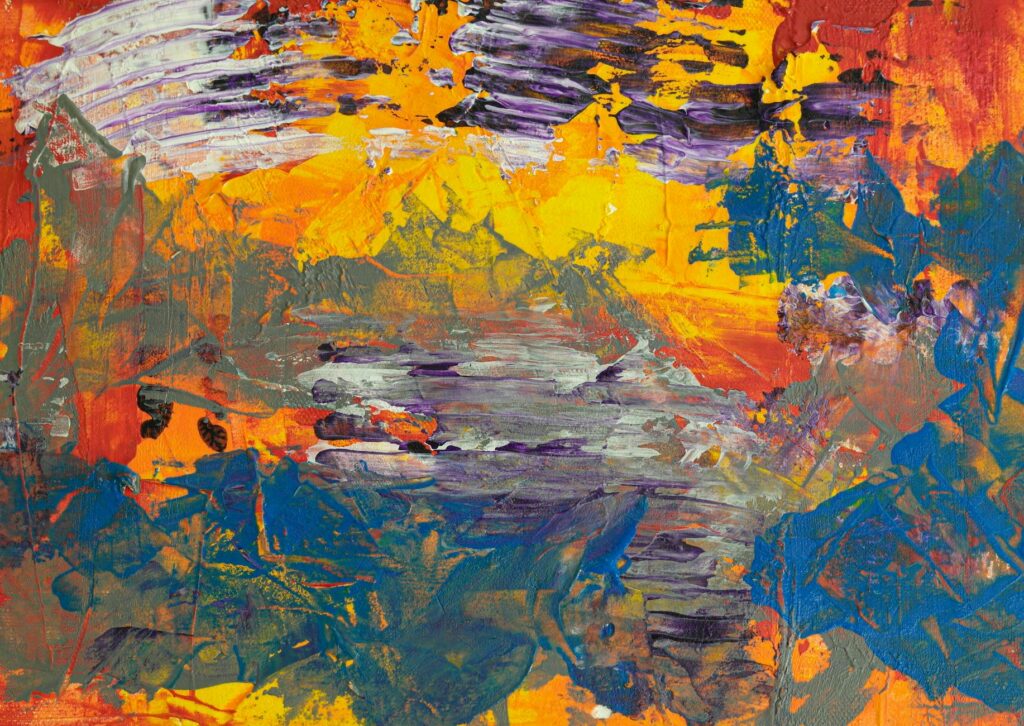When you look at paintings of winter snow, spring flowers, or autumn leaves, have you ever wondered why they look so different from artist to artist? The answer lies in understanding how art styles explained through seasonal themes reveals the unique approaches that different art movements take to capture the natural world. From the soft, dreamy brushstrokes of Impressionism to the precise details of Realism and the bold colors of Abstract art, each style tells the story of seasons in its own fascinating way.
Key Points Summary
- Three major art styles (Impressionism, Realism, Abstract) interpret seasons uniquely
- Impressionism captures seasonal light and atmosphere with loose brushwork
- Realism depicts seasons with photographic accuracy and precise detail
- Abstract art expresses seasonal emotions through color and form rather than literal representation
- Understanding these differences helps you appreciate and identify various art movements
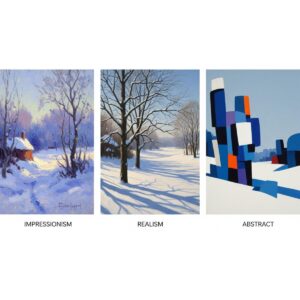
Understanding Art Movements and Seasonal Themes
Art movements are like different languages that artists use to express their ideas. When painters want to show the changing seasons, they choose techniques that match their artistic vision. Painting styles and movements have evolved over centuries, but three major approaches stand out when it comes to seasonal representation.
The beauty of studying seasonal art lies in how the same subject – whether it’s a snowy winter morning or a blooming spring garden – can look completely different depending on the artist’s style. This makes seasonal themes perfect for understanding different art styles and their unique characteristics.
How Impressionism Captures Seasonal Magic
Impressionism revolutionized how artists painted seasons by focusing on light and atmosphere rather than tiny details. When Impressionist painters like Claude Monet looked at a spring garden, they didn’t try to paint every single leaf. Instead, they captured how sunlight danced through the branches and how colors seemed to shimmer in the morning air.
Impressionist Techniques for Seasonal Paintings
Impressionist art characteristics become especially clear when you look at how these artists painted different seasons:
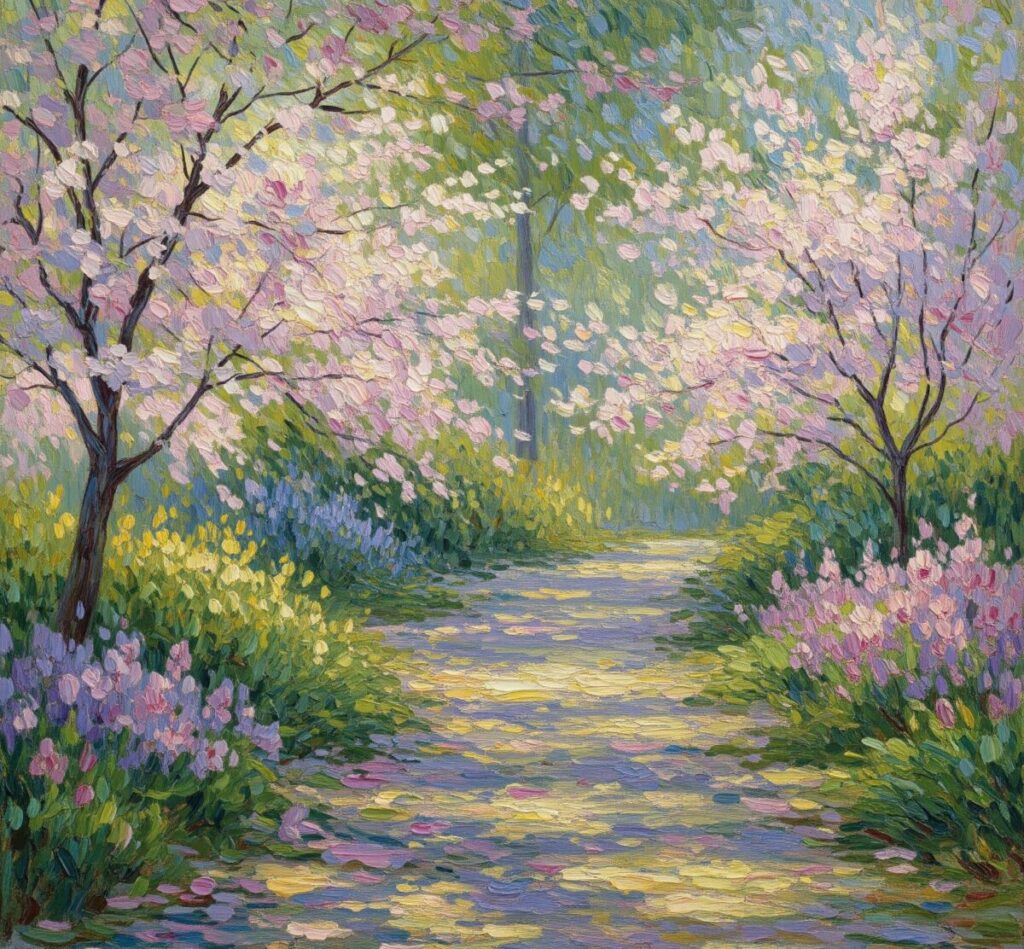
Spring Paintings:
- Short, quick brushstrokes that look like flower petals dancing in the breeze
- Soft pinks, light greens, and warm yellows mixed right on the canvas
- Blurred edges that make everything look dreamy and alive
Summer Scenes:
- Bright, vibrant colors applied in thick layers
- Strong contrast between light and shadow
- Mastering Impressionism light techniques shows how artists captured the intense summer sun
Autumn Landscapes:
- Warm oranges and reds applied with visible brushstrokes
- Colors that seem to glow from within the canvas
- Less sharp details, more focus on the overall feeling of the season
Winter Impressions:
- Cool blues and purples mixed with surprising warm tones
- Snow painted with thick, textured brushstrokes
- Emphasis on how winter light reflects off snow and ice
“I want to paint the air in which the bridge, the house, and the boat are to be found – the beauty of the air around them, and that is nothing less than the impossible.”
Claude Monet
Famous Claude Monet paintings demonstrate how one artist could paint the same garden in different seasons and create completely different moods using Impressionist techniques.
Realism: Capturing Seasons with Precision
While Impressionists painted their feelings about seasons, Realist artists took a completely different approach. Realism in art focuses on showing things exactly as they appear in real life, with incredible attention to detail and accuracy.
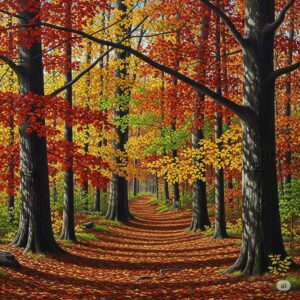
Realistic Seasonal Painting Methods
Realist painters spend countless hours studying how seasons actually look. They notice things like:
- How individual leaves change color at different rates
- The exact way snow accumulates on tree branches
- How morning frost creates patterns on grass
- The precise shadows cast by bare winter trees
Creating depth in paintings becomes crucial for Realist artists who want their seasonal scenes to look three-dimensional and believable. They use techniques like:
Edward Hopper paintings show how modern Realist artists captured the quiet beauty of American seasonal scenes with photographic precision.
| Technique | How It Works | Seasonal Example |
|---|---|---|
| Linear Perspective | Objects get smaller as they recede | Forest path disappearing into autumn woods |
| Atmospheric Perspective | Distant objects appear lighter and less detailed | Mountains fading into winter mist |
| Overlapping | Objects in front partially hide those behind | Summer flowers in front of garden fence |
| Color Temperature | Warm colors advance, cool colors recede | Bright autumn leaves against cool blue sky |
Art Styles Explained Through Abstract Seasonal Expression
Abstract art takes the boldest approach to depicting seasons. Instead of showing what seasons look like, abstract artists show what seasons feel like. They use pure color, shape, and form to express the emotions and energy of different times of year.
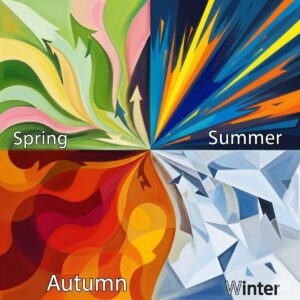
How Abstract Artists Interpret Seasons
Understanding abstract art helps us see how artists can communicate seasonal feelings without painting recognizable objects:
Spring Abstractions:
- Flowing, organic shapes that suggest growth and renewal
- Fresh greens mixed with soft yellows and pinks
- Upward movement in the composition
Summer Abstract Works:
- Bold, energetic forms that feel hot and alive
- Bright oranges, deep blues, and vibrant yellows
- Explosive patterns that radiate energy
Autumn Abstract Paintings:
- Warm, overlapping shapes that suggest falling and settling
- Rich reds, burnt oranges, and golden browns
- Compositions that feel heavy and grounded
Winter Abstract Art:
- Cool, stark geometric forms
- Blues, whites, and grays with sharp edges
- Minimal elements that feel quiet and still
Modern abstract painting techniques show how contemporary artists continue to explore seasonal themes through non-representational art.
Comparing Art Styles: Same Season, Different Stories
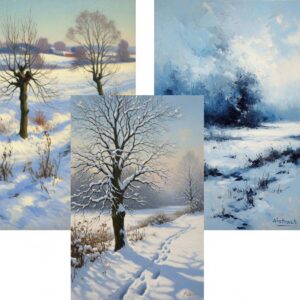
The most fascinating aspect of studying art styles explained through seasonal themes is seeing how three artists could paint the same winter landscape and create three completely different experiences:
- The Impressionist would focus on how winter light makes snow sparkle and how bare branches create interesting shadows
- The Realist would carefully paint every snowflake, every bare twig, and every footprint in the snow
- The Abstract artist would use cool blues and stark whites to make you feel the cold and isolation of winter
Understanding color theory in art helps explain why each style chooses different colors for the same seasonal scene.
Learning to Identify Art Styles in Seasonal Paintings
How to identify different art movements becomes easier when you know what to look for in seasonal artwork. Here are quick identification tips:
Look for Impressionist Signs:
- Visible brushstrokes that you can see from across the room
- Colors that seem to blend in your eye rather than on the canvas
- Soft, blurred edges especially around light sources
- Focus on light effects rather than perfect details
Spot Realistic Elements:
- Smooth paint application with no visible brushstrokes
- Sharp, clear details that look almost photographic
- Accurate proportions and perspective
- Careful attention to how light and shadow actually work
Recognize Abstract Approaches:
- Bold, expressive brushwork or unusual techniques
- Colors that might not match real life
- Emphasis on shapes, patterns, or emotions over realistic representation
- Non-literal interpretation of seasonal elements
Famous Artists and Their Seasonal Masterpieces
Here’s a comprehensive table showcasing how renowned artists from different art movements have captured the beauty of seasons in their most celebrated works:
Impressionist Masters and Seasonal Works
| Artist | Spring Paintings | Summer Paintings | Autumn Paintings | Winter Paintings |
|---|---|---|---|---|
| Claude Monet | The Artist’s Garden at Giverny (1900), Spring Effect at Giverny (1890) | Poplar Series (1891), Water Lilies series (1897-1926) | Autumn on the Seine at Argenteuil (1873), Charing Cross Bridge (1899) | Snow at Argenteuil (1875), The Magpie (1868-1869) |
| Pierre-Auguste Renoir | Spring Bouquet (1866), The Swing (1876) | Luncheon of the Boating Party (1880-1881), Dance at Moulin de la Galette (1876) | Autumn Landscape (1898), The Pear Tree (1902) | Snow-Covered Landscape (1875), Skaters in the Bois de Boulogne (1868) |
| Camille Pissarro | Spring, Pontoise (1877), Apple Trees in Bloom (1872) | Harvest at Montfoucault (1876), The Garden at Pontoise (1877) | Autumn Poplars (1893), Kitchen Garden at L’Hermitage (1874) | Snow Scene at Louveciennes (1870), Fox Hill, Upper Norwood (1870) |
| Edgar Degas | Spring (Woman with Chrysanthemums) (1865) | Beach Scene (1876-1877), At the Races (1877-1880) | Autumn Landscape (1890-1893) | Place de la Concorde (1875) |
Realist Artists and Seasonal Depictions
| Artist | Spring Paintings | Summer Paintings | Autumn Paintings | Winter Paintings |
|---|---|---|---|---|
| Gustave Courbet | Apple Trees in Blossom (1871), Spring Rutting Deer (1861) | Young Ladies on the Banks of the Seine (1856-1857), The Wheat Sifters (1854) | Hunting Dogs (1866), The Oak at Flagey (1864) | Winter Landscape (1868), The Source of the Loue (1864) |
| Jean-François Millet | Spring (1868-1873) | The Gleaners (1857), The Hay Harvest (1851) | Autumn, The Haystacks (1874), The Potato Harvest (1855) | Winter with Ravens (1862), Going to Work (1851-1853) |
| Edward Hopper | Room in New York (1932) | Nighthawks (1942), Cape Cod Evening (1939) | October on Cape Cod (1946), Automat (1927) | Gas (1940), Hotel Room (1931) |
| Andrew Wyeth | Spring Fed (1967), May Day (1960) | Christina’s World (1948), Wind from the Sea (1947) | Autumn Leaves (1956), Trodden Weed (1951) | Snow Flurries (1953), Winter 1946 (1946) |
Post-Impressionist Seasonal Works
| Artist | Spring Paintings | Summer Paintings | Autumn Paintings | Winter Paintings |
|---|---|---|---|---|
| Vincent van Gogh | Almond Blossom (1890), The Pink Peach Tree (1888) | The Starry Night (1889), Wheatfield with Cypresses (1889) | Autumn Landscape (1885), The Mulberry Tree (1889) | Snowy Landscape with Arles (1888), Winter Garden (1884) |
| Paul Cézanne | Spring House (1879-1882), Chestnut Trees at Jas de Bouffan (1885-1887) | Mont Sainte-Victoire series (1882-1906), The Large Bathers (1895-1906) | Autumn (1860-1862), Forest Interior (1898-1899) | Winter Landscape (1895-1898), Melting Snow at Fontainebleau (1879-1880) |
| Georges Seurat | A Sunday on La Grande Jatte (1884-1886) | Bathers at Asnières (1884), The Channel at Gravelines (1890) | Autumn Landscape (1884) | Winter Landscape (1882-1883) |
Abstract and Modern Artists’ Seasonal Interpretations
| Artist | Spring Works | Summer Works | Autumn Works | Winter Works |
|---|---|---|---|---|
| Wassily Kandinsky | Spring (1938), Composition VII (1913) | Summer (1938), Yellow-Red-Blue (1925) | Autumn (1938), Several Circles (1926) | Winter (1938), Composition VIII (1923) |
| Piet Mondrian | Flowering Apple Tree (1912), Trees in Bloom (1912) | Pier and Ocean series (1914-1915) | Autumn Tree (1911), Red Tree (1908-1910) | Gray Tree (1911), Winter Trees (1908-1909) |
| Georgia O’Keeffe | Spring Tree No. 1 (1945), Pink Moon and Blue Lines (1952) | Summer Days (1936), Red Hills and Bones (1941) | Autumn Leaves (1924), Red Maple (1922) | Winter Road I (1963), From the Plains II (1954) |
| David Hockney | Spring from The Four Seasons (2010-2011) | Summer from The Four Seasons (2010-2011) | Autumn from The Four Seasons (2010-2011) | Winter from The Four Seasons (2010-2011) |
Contemporary Artists and Seasonal Themes
| Artist | Notable Seasonal Series | Time Period | Style Approach |
|---|---|---|---|
| Peter Halley | Four Seasons series | 1990s-2000s | Neo-Geometric Abstract |
| Gerhard Richter | Seasonal Abstracts | 1980s-2010s | Photo-Realism to Abstract |
| Anselm Kiefer | Seasonal Landscapes | 1970s-Present | Neo-Expressionist |
| Jeff Koons | Seasons sculpture series | 1990s-2000s | Pop Art/Conceptual |
Regional Seasonal Specialists
| Artist/Region | Specialty | Famous Seasonal Works | Cultural Influence |
|---|---|---|---|
| Hokusai (Japanese) | Four Seasons Prints | Thirty-six Views of Mount Fuji series | Traditional Japanese seasonal aesthetics |
| Tom Thomson (Canadian) | Northern Seasons | The Jack Pine (1916-1917), Northern River (1915) | Canadian wilderness landscapes |
| Aboriginal Australian Artists | Seasonal Dreamtime | Various seasonal ceremony paintings | Indigenous seasonal cycles |
| Scandinavian Artists | Nordic Seasons | Winter and summer light studies | Extreme seasonal light variations |
This comprehensive table shows how artists across different movements, time periods, and cultures have been inspired by seasonal changes. From Monet’s revolutionary light studies to contemporary abstract interpretations, seasons continue to provide rich material for artistic expression. Notice how different art styles approach the same seasonal subjects with completely different techniques and emotional outcomes.
The table also demonstrates how famous artist styles evolved over time, with earlier artists focusing on realistic seasonal depictions while modern and contemporary artists explore more abstract and conceptual approaches to seasonal themes.
Why Understanding Art Styles Matters
Learning about different art styles through seasonal themes helps you become a better art appreciator and gives you tools to understand any painting you encounter. Whether you’re visiting a museum, shopping for art, or just curious about what makes each painting special, knowing these basic approaches opens up a whole new world of understanding.
How to appreciate art starts with recognizing the different ways artists can approach the same subject. Seasonal themes provide the perfect introduction because everyone has experienced the changing seasons and can relate to the emotions and memories they evoke.
Frequently Asked Questions
What is the difference between impressionism and abstract art? Impressionism still shows recognizable objects like trees, flowers, and buildings, but with loose, visible brushstrokes and emphasis on light effects. Abstract art may not show recognizable objects at all, instead using color, shape, and form to express ideas or emotions.
How can you tell if a painting is realistic or impressionistic? Look at the brushwork and details. Realistic paintings have smooth paint application and sharp, clear details. Impressionistic paintings have visible brushstrokes and softer, blurred edges, especially around light sources.
What are the main characteristics of abstract art? Abstract art emphasizes color, form, line, and texture over realistic representation. It may use recognizable elements but arranges them in non-realistic ways, or it may be completely non-representational.
How do artists capture different seasons in paintings? Artists use different color palettes, lighting effects, and subject matter for each season. They also adjust their techniques – for example, using warmer colors and flowing brushstrokes for summer, or cooler colors and sharper edges for winter.
What makes impressionist seasonal paintings unique? Impressionist seasonal paintings focus on capturing the changing light and atmosphere of each season rather than precise details. They use loose, visible brushstrokes and often paint outdoors to capture natural light effects.
Understanding art styles explained through the lens of seasonal painting helps you see how artists throughout history have found different ways to capture the beauty and emotion of nature’s changing cycles. Whether you prefer the dreamy atmosphere of Impressionism, the precise beauty of Realism, or the bold expression of Abstract art, each style offers its own unique window into the artistic interpretation of our natural world.

